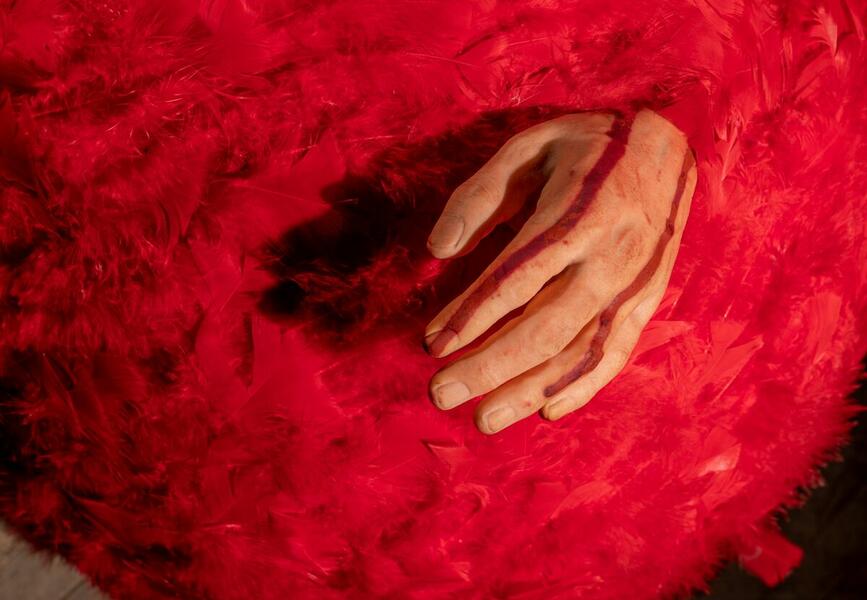LYGIA PAPE’S EXHIBITION AT HAUSER & WIRTH REFLECTS ON THE TUPINAMBÁ SPIRIT
A significant Brazilian artist of her generation and a founding member of Brazil’s Neo-Concrete movement, Lygia Pape (1927 – 2004) favored the primacy of the viewer’s sensorial experience and its role in everyday life. Examining the artist’s unique reframing of geometry, abstraction and poetry, ‘Tupinambá’ is the first solo exhibition in Los Angeles dedicated to Pape’s work and is organized with Projeto Lygia Pape and Olivier Renaud-Clément. Central to the show will be the Tupinambá series, one of the artist’s final bodies of work, revealing her desire to create more immersive experiences beyond the conventional boundaries of life and art.

Lygia Pape’s work traverses a diverse spectrum of media and genres, including sculpture, engraving, painting, drawing, performance, filmmaking, video, and installation art. Born in Nova Friburgo, Rio de Janeiro in 1927, Pape worked in close dialogue with the Concrete and Neo-Concrete movements active in Brazil during the 1950s and 1960s. Along with her fellow Neo-Concretists, Pape ultimately sought to challenge the tenets of abstraction underpinning the aesthetic philosophy of Concrete art, and to move toward a greater sensorial, organic and phenomenologically attuned mode of expression.
Exhibited for the first time in the US, the works on view from the Tupinambá series – distinctive in their use of artificial red feathers – illuminate Pape’s sense of connection to Brazil’s indigenous populations and certain characteristics of their history.
Featuring one of the most commanding and rarely seen bodies of work by Lygia Pape, the exhibition introduces her deeply Brazilian Tupinambá series to a North American audience for the first time. Pape devised a wholly original language during her career to investigate the physical and experiential life of the body, and with this series achieves an unprecedented union of the geometric and the figurative within the wider context of her oeuvre. Here, Pape proposes a refreshingly divergent understanding of Brazil’s modernist history, suggesting that the aesthetic prerogatives of the present are firmly rooted in the nation’s indigenous past.
-
Lygia Pape © Projeto Lygia Pape. Courtesy Projeto Lygia Pape and Hauser & Wirth. Photograph © 2020 Fredrik Nilsen.
-
Lygia Pape © Projeto Lygia Pape. Courtesy Projeto Lygia Pape and Hauser & Wirth. Photograph © 2020 Fredrik Nilsen.
-
Lygia Pape © Projeto Lygia Pape. Courtesy Projeto Lygia Pape and Hauser & Wirth. Photograph © 2020 Fredrik Nilsen.
-
Lygia Pape © Projeto Lygia Pape. Courtesy Projeto Lygia Pape and Hauser & Wirth. Photograph © 2020 Fredrik Nilsen.
-
Lygia Pape © Projeto Lygia Pape. Courtesy Projeto Lygia Pape and Hauser & Wirth. Photograph © 2020 Fredrik Nilsen.
The Tupinambá series thus reflects Pape’s longtime interest in indigenous Brazilian peoples and cultural practices—most notably that of anthropophagy, a ceremonial variant of cannibalism practiced by the Tupinambá people. She describes it as follows: “The Tupinambá devoured their prisoners, their enemy, not from hunger as in cannibalism, but to swallow and assimilate the spiritual capacities of the other.” Anthropophagy thus possesses a dual valence, in one sense it is literal and ritualistic, and in another, cultural and metaphorical.
By employing a host of powerful symbols that evoke the ancient Tupinambá ritual, Pape poetically reimagines and reclaims her nation’s fraught past in these distinctive forms. Defined by a bold use of red plumage—alluding to feather capes originally made with the red feathers of the Guará bird and worn by the Tupinambá when performing their anthropophagic ritual—the works on view are also adorned with cockroaches and protruding body parts, cohering in a totalizing vision of ghostly sensuality. Here, the uncanny beauty, violence, and objectification of the body are viscerally felt by the viewer.
Punctuating the exhibition is a selection of Pape’s ‘Desenhos’ (Drawings) from the 1980s, which serve to anchor her later work in the historic lineage of Neo-Concretism and highlight her artistic trajectory toward an increasingly political and environmentally-minded practice, exemplified by the Tupinambá series. The early ‘Desenhos’ possess a rhythm and cadence evocative of both music and geometrical abstraction. By uniting these two modalities, Pape manifested the very tenets of the Neo-Concrete movement that she, along with Lygia Clark and Hélio Oiticica, defined years prior—those which seek to break barriers between the intuitive and the intellectual, the spirit and the body—in the construction of a rebellious, unprecedented, and uniquely Brazilian avant-garde.
-
Lygia Pape © Projeto Lygia Pape. Courtesy Projeto Lygia Pape and Hauser & Wirth. Photograph © 2020 Fredrik Nilsen.
-
Lygia Pape © Projeto Lygia Pape. Courtesy Projeto Lygia Pape and Hauser & Wirth. Photograph © 2020 Fredrik Nilsen.
-
Lygia Pape © Projeto Lygia Pape. Courtesy Projeto Lygia Pape and Hauser & Wirth. Photograph © 2020 Fredrik Nilsen.
-
Lygia Pape © Projeto Lygia Pape. Courtesy Projeto Lygia Pape and Hauser & Wirth. Photograph © 2020 Fredrik Nilsen.
-
Lygia Pape © Projeto Lygia Pape. Courtesy Projeto Lygia Pape and Hauser & Wirth. Photograph © 2020 Fredrik Nilsen.
Most recently, Pape’s work has been exhibited in solo shows at the Museo Reina Sofia in Madrid, the Serpentine Gallery in London (2011), the Pinacoteca do Estado de São Paulo, Brazil (2012), the Fondazione Carriero in Milan (2019), the Moderna Museet in Stockholm (2018) and at Hauser & Wirth in New York (2018) and London (2016). In 2017, The Met Breuer in New York mounted the first large-scale monographic survey of her work in the United States.


